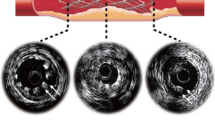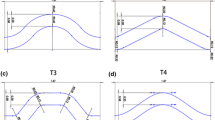Abstract
Cardiovascular stents have been used since the 1990s to treat atherosclerosis, one of leading causes of death in the western world, and structural optimization has led to significant improvements in stent performance. Much of the potential variation in stent geometry, however, has remained unconsidered. This paper presents a non-uniform rational basis spline (NURBS) parameterization of a stent, the inclusion of structural fatigue resistance as a design consideration, and the results of a design optimization based on response surface techniques. Results show the feasibility and merits of the NURBS approach, which models a much broader range of shapes than was previously possible. Multi-objective optimization produces a range of geometrically diverse Pareto-optimal designs; these can be used to develop future clinical design guides, accounting for the variation observed across patients. We conclude by motivating future work with increasingly complex physical modeling and optimization capabilities.










Similar content being viewed by others
References
Atherton MA, Bates RA (2004) Robust optimization of cardiovascular stents: a comparison of methods. Eng Optim 36(2):207– 217
Balcon R, Beyar R, Chierchia S, De Scheerder I, Hugenholtz PG, Kiemeneij F, Meier B, Meyer J, Monassier JP et al (1997) Recommendations on stent manufacture, implantation and utilization. Eur Heart J 18:1536–1547
Bennett MR (2003) In-stent stenosis: pathology and implications for the development of drug eluting stents. Heart 89(2):218– 224
Deb K, Pratap A, Agarwal S, Meyarivan T (2002) A fast and elitist multiobjective genetic algorithm: NSGA-II. IEEE Trans Evol Comput 6(2):182–197
Duggan TV, Byrne J (1977) Fatigue as a design criterion, vol 77. Macmillan, London
Dumoulin C, Cochelin B (2000) Mechanical behaviour modelling of balloon-expandable stents. J Biomech 33(11):1461–1470
Etave F, Finet G, Boivin M, Boyer JC, Rioufol G, Thollet G (2001) Mechanical properties of coronary stents determined by using finite element analysis. J Biomech 34(8):1065–1075
Harewood F, Thornton R, Ireland M, Sharp P (2011) Step change in design: exploring sixty stent design variations overnight. Altair Product Design Workshop
Hastie T, Tibshirani R, Friedman J, Franklin J (2005) The elements of statistical learning: data mining, inference and prediction. Math Intell 27(2):83–85
Kelliher D, Clune R, Campbell JS, Robinson JC, Appelbe B, Buttimer C (2008) Sensitivity of shape change on the performance of stainless steel cardio-vascular stents. In: Proceedings of the 7th ASMO UK conference on engineering design optimization, Bath, pp 274–283
Lally C, Dolan F, Prendergast PJ (2005) Cardiovascular stent design and vessel stresses: a finite element analysis. J Biomech 38(8):1574–1581
Li N, Zhang H, Ouyang H (2009) Shape optimization of coronary artery stent based on a parametric model. Finite Elem Anal Des 45(67):468–475
McKay MD, Beckman RJ, Conover WJ (1979) Comparison of three methods for selecting values of input variables in the analysis of output from a computer code. Technometrics 21(2):239–245
Migliavacca F, Petrini L, Colombo M, Auricchio F, Pietrabissa R (2002) Mechanical behavior of coronary stents investigated through the finite element method. J Biomech 35(6):803–811
Myers RH, Montgomery DC, Anderson-Cook CM (1971) Response surface methodology. Allyn and Bacon, Boston
Nielsen HB, Lophaven SN, Sondergaard J (2007) DACE: a matlab kriging toolbox. http://www2.imm.dtu.dk/hbni/dace/
Pant S, Bressloff NW, Limbert G (2011a) Geometry parameterization and multidisciplinary constrained optimization of coronary stents. Biomech Model Mechanobiol 11(1–2):61–82
Pant S, Limbert G, Curzen NP, Bressloff NW (2011b) Multiobjective design optimisation of coronary stents. Biomaterials 32(31):7755–7773
Piegl LA, Tiller W (1997) The NURBS book. Springer Verlag
Qian X (2010) Full analytical sensitivities in NURBS based isogeometric shape optimization. Comput Methods Appl Mech Eng 199(29):2059–2071
Serruys PW (2001) Handbook of coronary stents. Recherche67:02
Seshadri A (2009) NSGA - II: a multi-objective optimization algorithm - MATLAB file exchange., http://www.mathworks.com/ matlabcentral/fileexchange/10429-nsg a-ii-a-multi-objective-opti- mization-algorithm
Shen X, Yi H, Ni Z (2008) Effects of stent design parameters on radial force of stent. In: The 2nd international conference on bioinformatics and biomedical engineering. ICBBE 2008, IEEE, pp 1712–1716
Timmins L, Moreno M, Meyer C, Criscione J, Rachev A, Moore J (2007) Stented artery biomechanics and device design optimization. Med Biol Eng Comput 45(5):505–513
Wu W, Yang DZ, Huang YY, Qi M, Wang WQ (2008) Topology optimization of a novel stent platform with drug reservoirs. Med Eng Phys 30(9):1177–1185
Xiang S, Hong Y, Zhonghua N, Xingzhong GU (2008) Optimization of coronary stent structure design for maximizing the anti-compression mechanical property. Chin J Mech Eng 21(6)
Acknowledgments
The authors wish to thank Dr. Brendan Cunniffe, formerly of Medtronic Vascular, Galway, Ireland, for his help on this project.
Author information
Authors and Affiliations
Corresponding author
Rights and permissions
About this article
Cite this article
Clune, R., Kelliher, D., Robinson, J.C. et al. NURBS modeling and structural shape optimization of cardiovascular stents. Struct Multidisc Optim 50, 159–168 (2014). https://doi.org/10.1007/s00158-013-1038-y
Received:
Revised:
Accepted:
Published:
Issue Date:
DOI: https://doi.org/10.1007/s00158-013-1038-y




